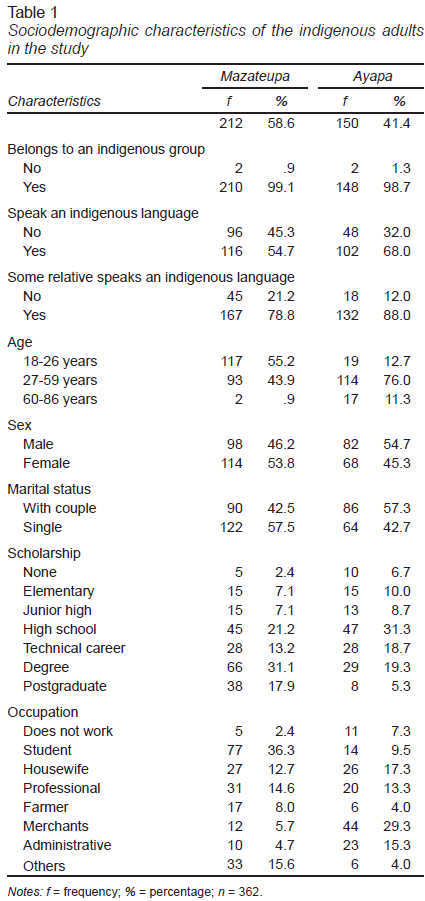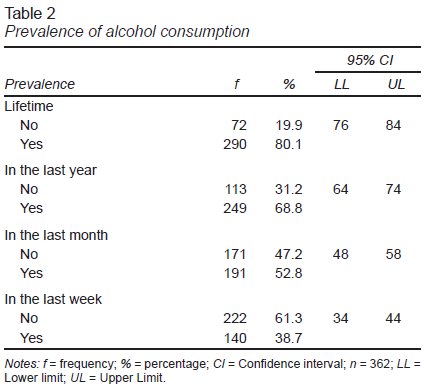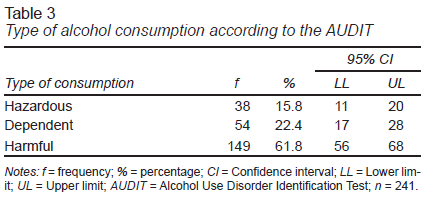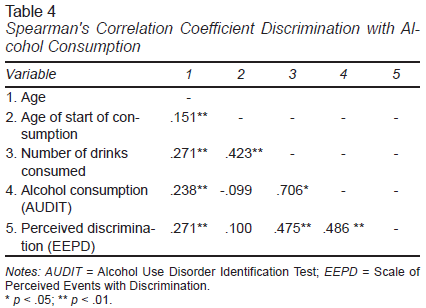Introduction
The General Consultation Report on Alcoholism and Indigenous people indicates that these populations are considered minoritarian and vulnerable since they have characteristics such as poverty, difficulty in accessing food, housing, and educational. These conditions make them prone to problems like alcohol dependence (Comisión Nacional para el Desarrollo de los Pueblos Indígenas [CDI], 2008).
A study carried out on indigenous population of Mexico City reported that excessive alcohol consumption occurred in 20.9% of indigenous men and 24% of non-indigenous men. In indigenous women, the prevalence of this consumption was 22.9% versus 21% of non-indigenous women (Vega et al., 2015). Although there is not much difference between alcohol consumption in indigenous and non-indigenous populations, it is important to mention that indigenous populations are often characterized by a low economic status and so the consequences of alcohol consumption are more severe in people with malnutrition (Fundación de Investigaciones Sociales, 2002).
It is also important to point out that alcohol dependence consumption is likely to arise as a symbol of protest, challenge, and action to social anguish, which has repercussions on marginal population sectors that have fragility conditions due to exploitation and discrimination, such as indigenous people (Almaguer, García, & Vargas, 2017). The discrimination factor refers to patterns that generate unequal practices and strategies designed to exclude any social group, such as indigenous population.
In this way, a qualitative study carried out in Canada about the experiences of the medical care of indigenous people highlights that participants expressed that, in their interaction with health personnel, they experienced discrimination, in addition to being stigmatized by the stereotypes that link indigenous people with substance use (Goodman et al., 2017). In the same way a study carried out in Australia about the indigenous workers alcohol consumption refers that discrimination is a source of isolation and depression that returns to the indigenous people most vulnerable to turning to alcohol as a source of support to overcome stressful situations (Roche et al., 2013).
In their study of the trajectory of alcohol consumption and drinking problems during adolescence in an indigenous population of North America, Cheadle and Whitbeck (2011) found that perceived discrimination predicts an early start of alcohol consumption (Z = 1.30 [2.32], p < .05). They also found that the perception of discrimination is positively related to alcohol abuse or dependence (t = 2.02, p < .05). This adds up to the fact that perceived discrimination increases the probability of abuse and dependence on alcohol by 22%.
It is important to mention here that there is little evidence of how perceived discrimination affects alcohol consumption in Mexican indigenous populations. For this reason, the objective of this study is to learn about the effect of perceived discrimination on alcohol consumption in Mexican indigenous populations.
Method
Design of the study
The study design was cross sectional, for model verification, as it sought to examine the relationships between the variables perceived, discrimination and alcohol consumption, and the model verification because the effect of the perceived discrimination variable on alcohol consumption will be measured.
Description of the sample
The population was made up by indigenous adults from the town of Mazateupa, in the municipality of Nacajuca, and Ayapa, in the municipality of Jalpa de Méndez, Tabasco, Mexico. Together, these localities have a population of 3,598 adults of over 18 years of age of both sexes (Instituto Nacional de Estadística y Geografía [INEGI], 2010). The sample size was calculated using the statistical program n’Query Advisor®, version 7.0 (Elashoff, Dixon, Crede, & Fothenringham, 2007), for a proportion with a significance level of .95 for a two-sided interval, an estimation error limit of .05%, Power at 90% with a coefficient of determination of .05%, considering a non-response rate of 5%, thus obtaining a final sample of 362 indigenous adults. The sampling was non-probabilistic for convenience by quota.
Measurements
A Personal Data and Prevalence of Alcohol Consumption Card (CDPPCA) was used together with the Scale of Events Perceived as Discrimination (Escala de Eventos Percibidos como Discriminación, EEPD), and the Alcohol Use Disorder Identification Test (AUDIT).
The personal Data and Consumption Prevalence Card includes sociodemographic data and four questions on the prevalence of alcohol consumption, lifetime, in the last year, in the last month, and in the last week. In addition, two questions that examine the age of start of alcohol consumption and the number of drinks consumed on a typical day are included.
The Scale of Events Perceived as Discrimination is a questionnaire created by Moreno in 2011 with the aim of measuring the perception of social discrimination among the Costa Rican indigenous population, which is understood as the opinion that people have of being treated unfairly, which is directly related to being part of an ethnic group.
It is made up of 22 questions in total, which are subdivided into two sections. The first one is composed of 16 items that examine events perceived as discrimination, and the responses have a Likert-type format with four options (Moreno, 2011). The second section measures the perception of discrimination with two scales, with six items, with a Likert-type response format of four options.
To evaluate the questionnaire, the responses of each of the two sections of the questionnaire are summed, where the first section has a minimum score of 16 and a maximum of 64 points, while the second section has a minimum score of 6 and a maximum of 24. The estimate indicates that the higher the score obtained is the greater the perception of social discrimination. This instrument was used in a study with a Costa Rican indigenous population, and an adaptation of the questionnaire was made for the Mexican indigenous population by the authors of this research as original document used terms that are not applicable at local population having for the first section a Cronbach above α = .70 and for the second section a Cronbach above α = .80 (Moreno, 2011). In the present study, a Cronbach alpha was obtained from the first section of α = .89 and in the second section, α = .76, the scale in general presented a Cronbach alpha of α = .90.
The Alcohol Use Disorders Identification Test (AUDIT) was adapted for the Mexican population by de la Fuente and Kershenobich (1992). This instrument explores alcohol consumption during the last twelve months, the problems that occur due to consumption, as well as it identifies the patterns of alcohol consumption (hazardous, dependence, and harmful), “hazardous drinking is a pattern of alcohol consumption that increases the risk of harmful consequences for the user or, dependence use refers to alcohol consumption that results in consequences to physical and mental health, and harmful alcohol use is a cluster of behavioural, cognitive, and physiological phenomena that may develop after repeated alcohol use” (World Health Organization, 2001), others, it is made up of 10 items with a score that ranges from 0 to 40 points. The classification of the consumption type is obtained by adding 1 point to each positive answer. This creates a range that goes from 1 to 3 considering hazardous consumption, 4 to 7 as dependent consumption, and 8 to 40 it is considered harmful consumption, as higher the score, higher is alcohol consumption. In rural populations in Mexico, a Cronbach’s alpha of α = .78 has been reported (Alonso et al., 2016). In this study, a Cronbach’s α = .87 was obtained.
Procedure
First, authorization was requested from the delegate of the indigenous communities and the authorities of the health center. They contacted afterwards the community health personnel, who were trained to carry out the promotion of the survey and the interview. Through the health center, people who attended for consultation were contacted. Those who agreed to participate attended a doctor’s office where the informed consent was read and signed. The application of the instruments was then carried out through direct interview (face to face), as studied population speak Spanish as second language, as covid pandemic was present at the time all interviews were one at a time, after each interview a sanitize process was made in the room, and both interviewer and subject used face mask and alcohol to sanitize hands.
Statistical analysis
The Statistical Package for the Social Sciences, version 25, was used. Descriptive statistics were used for the sociodemographic data of the sample, for the prevalence of consumption and the AUDIT test, descriptive statistics and 95% confidence intervals were used for continuous variables the Kolmogorov-Smirnov with Lilliefors correction to know normality in variables, since they did not present normality non-parametric statistics were used, the Spearman correlation and the linear regression test.
Ethical considerations
The study adhered to the Regulation of the General Health Law on Health Research Matters (Secretaría de Salud [SS], 1987), in its Last Reform (DOF 04-02-2014). This document has the approval of the ethics and research committee of the School of Nursing of a public university in the state of Nuevo León, Mexico, with folio No. 19-CEI-004-20180614.
Results
Table 1 describes the sociodemographic data of the indigenous populations studied, 58.6% of the total sample belong to the indigenous locality of Mazateupa, in this locality 99.1% identify themselves as part of an indigenous community, in what concerns the speak an indigenous language, 54.7% say they do, and 78.8% have a family member who speaks this language, the age group with the highest percentage with 55.2% was 18-26 years, regarding sex, the highest prevalence was female with 53.8%, 57.5% of the population is classified as single, 31.1% has a bachelor’s degree, and 36.3% identifies as a student.
The indigenous population of Ayapa represents 41.4% of the total sample of this study, where 98.7% feels that they belong to an indigenous group, 68% speak an indigenous language, likewise 88% report that they have a family member who speaks some indigenous language, the age group with the highest percentage was 27-59 years with 76%, the predominant sex was male with a prevalence of 54.7%, 57.3% declared themselves with a partner, regarding schooling, high school presented 31.3%, finally the most frequent occupation is merchant with 29.3%.
Regarding the age of initiation of alcohol consumption, the minimum age was eight years and the maximum was 26 years (SD = 7.50), with a mean X̄ = 13.91 years (Mdn = 16.0); Regarding sex, the age of initiation of alcohol consumption in males was between 10 and 25 years of age (SD = 6.86), with a mean X̄ = 17 years (Mdn = 14.59), in females the age of onset of alcohol consumption is between eight and 26 years old (SD = 8.05), with a mean age of X̄ = 16 years (Mdn = 13.24).
According to the prevalence on alcohol consumption (Table 2), it was obtained that 80.1% of the participants have consumed alcohol at least one in a lifetime, 68.8% report consumption in the last year, 52.8% in the last month, and 38.7% in the last week.
According to the types of alcohol consumption of the study participants, it is shown that 15.8% have a hazardous consumption, 22.4% dependent consumption, and 61.8% harmful consumption (Table 3). Regarding the Scale of Events Perceived as Discrimination, a mean X̄ = 41.42 (Mdn = 42), with a minimum score of 22 and a maximum of 75 (SD = 11.73).
For continuous variables, the Kolmogorov-Smirnov Test was performed, where the variables did not show normality, so it was decided to use non-parametric statistics.
The results of the Spearman Correlation Coefficient (Table 4) show that perceived discrimination was related to the number of drinks consumed (rs = .475, p < .001), as well as the perceived discrimination variable was related to the consumption of alcohol (AUDIT; rs = . 486, p < .001), which means that the more discrimination is perceived by the indigenous population, the greater the number of drinks consumed on a typical day and the greater the alcohol consumption, as additional findings, it is shown that age was related to perceived discrimination (rs = .271, p < .01) that as the older the age, the greater the perceived discrimination, age was related to the number of drinks consumed (rs = .271, p < .001), and with AUDIT alcohol consumption (rs = .238, p < .01), that is, the older the age, the greater the alcohol consumption by the indigenous participants.
Finally, a simple linear regression model was carried out to observe the effect of discrimination on alcohol consumption (Table 5), in which a significant effect is reported in the entire model (F[248] = 78.312, p = .001), explaining 49% of the variance of alcohol consumption. Perceived discrimination (β = .626, p < .001) was found to have a positive and significant effect on alcohol consumption.
Discussion and conclusion
The results found in the present study show that the average age of beginning of alcohol consumption in indigenous women is below the national average reported, in a national study on alcohol consumption, this shows that the indigenous women from these communities of Tabasco had started alcohol consumption at an earlier age than non-indigenous women (INPRFM, INSP, CONADIC, & SS, 2017). In addition to the above, Ahumada-Cortez, Gámez-Medina, and Valdez-Montero (2017), state that there is currently greater homogeneity between gender roles.
All the prevalence of alcohol consumption in this study presented higher percentages compared to the results shown by the ENCODAT 2016-2017; In addition to the above, harmful consumption presented the highest percentage of consumption, these results support what was stated by the Mexican organizations that studies diverse characteristics of indigenous peoples (CDI, 2008), which mentions that indigenous populations are more likely to have problems with alcohol consumption. The indigenous communities in this study have characteristics that the literature highlights as risk factors for developing alcohol addictive behaviors such as poverty, domestic violence, mental health problems, availability and accessibility of alcohol, and community policies conducive to alcohol consumption, such as the sale of alcohol in places not regulated by law (Becoña et al., 2010; Gómez-Restrepo, Rincón, & Urrego-Mendoza, 2016).
The scores obtained in the present study on perceived discrimination were high, this shows that indigenous people feel discriminated, which coincides with what was obtained by the National Survey of Discrimination in Mexico (Encuesta Nacional de la Discriminación en México, 2010), which mentions that the people who belong to Indigenous communities manifest discrimination as a primary problem in their daily life.
It is worth mentioning that in the context in which the study was developed, indigenous people felt uncomfortable if they were interviewed by people who did not have physical characteristics similar to those they consider typical of indigenous people, they said that they feel attacked if a person that they consider non-indigenous, classifies them as indigenous, because they perceive that being classified as indigenous by non-indigenous populations is linked to stupid, aggressive and ignorant people, it is important to note that this phenomenon is considered as internalized racism (David, Schroeder, & Fernandez, 2019), which is a characteristic that communities that have been constantly and systematically discriminated against, this causes that over time, the negative ideas expressed by the oppressive group, becomes a reality in the oppressed group and they conceive them as their own, which leads them to adopt a behavior according to what their oppressors expect of them.
Regarding discrimination, it present an effect on alcohol consumption, which shows that it is an important factor to take into account in the study of the phenomenon of alcohol consumption in indigenous populations, these results coincide with that reported by Cheadle and Whitbeck (2011), based on a study carried out in an American indigenous population, this study reported that the perception of discrimination is positively related to alcohol abuse or dependence.
In conclusion, indigenous populations present discrimination problems that lead them to develop problems with alcohol consumption, it is important to take into account that it is necessary to continue the study of discrimination perceived by indigenous populations as well as the problem of alcohol consumption.
The limitations of the study were due to the fact that the sampling was not probabilistic derived from the limitations that were imposed by the pandemic.




